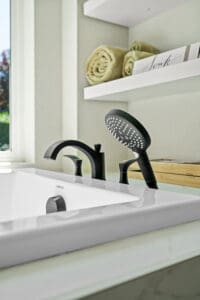The Best Ways To Soundproof Your Home Office In The Bay Area
Alright, let’s talk about one of the modern world’s great productivity killers: noise. You’re on a crucial video call, and suddenly your neighbor’s dog decides it’s the perfect time to have a heartfelt conversation with a squirrel. Or maybe the garbage truck’s symphony of beeps and crunches becomes the uninvited background music for your quarterly report. We feel you. Soundproofing your home office isn’t just a luxury anymore; it’s a necessity for sanity and professionalism, especially here in the bustling Bay Area.
We’ve tackled noise in all sorts of spaces, from whole house remodeling projects in Danville to custom remodels in Oakland. The principles are the same, whether you’re dealing with a dedicated room or a carved-out corner. So, grab a coffee, and let’s dive into making your workspace the quiet, focused sanctuary it deserves to be.
Understanding the Sound Basics (It’s Not Magic, It’s Physics)
Before we start hanging egg cartons on the walls (please don’t do that), we need to understand our enemy. Sound travels in waves, and it does two main things we want to stop: it leaks through air gaps (like under a door), and it vibrates through solid materials (like your walls). Our mission is to block, absorb, and dampen.
Think of it this way: sealing gaps is like fixing a leaky boat, while adding mass to your walls is like building a thicker hull. Sometimes, you need both. Ever wonder why you can hear every footstep from the room above? That’s impact noise traveling through the structure. It’s a different beast from the airborne noise of a lawnmower outside your window.
Your First Line of Defense: The Quick and Easy Wins
You don’t necessarily need to call a home renovation contractor for a major project right off the bat. Let’s start with the low-hanging fruit that can make a surprisingly big difference. These are the weekend warrior projects that won’t break the bank.
Seal Those Gaps
Sound is a sneaky opportunist, and it will find any tiny crack to exploit. Your first and most cost-effective step is to play detective and find those leaks.
- Weatherstripping is Your Friend: Apply self-adhesive weatherstripping tape around the perimeter of your office door. We’re talking about the kind you’d use for a drafty window. It’s cheap and incredibly effective.
- Don’t Forget the Bottom: A door sweep is a game-changer. It’s a strip of rubber or bristles that attaches to the bottom of your door, sealing the gap between the door and the floor. It’s arguably the single best bang-for-your-buck soundproofing item you can buy.
- Outlet Insulation: This one sounds minor, but it works. Those electrical outlets on shared walls are basically little holes straight to the other side. You can buy special foam gaskets for a few dollars, turn off the power, remove the outlet cover, and place the gasket behind it. It’s a five-minute job with a noticeable payoff.
Rearrange and Soften
Sometimes, the solution isn’t about adding stuff, but about rearranging what you already have.
- Bookcases as Barriers: Got a tall bookcase? Load it up with books and push it against the noisiest wall in your office. All those books and the solid back of the bookcase add mass and create a barrier, absorbing and blocking sound.
- Rugs and Thick Curtains: Hard surfaces reflect sound, making a room echoey and allowing noise to bounce around. A thick, plush rug on the floor does wonders, especially if you have hardwood or tile. Similarly, heavy, dense curtains over the window can soak up a significant amount of street noise. It’s a simple aesthetic upgrade that doubles as a sound dampener.
Leveling Up: More Involved (But Worth It) Solutions
If the easy fixes aren’t cutting it and the sound of your neighbor’s bass is still dictating your heart rate, it’s time to level up. These projects require a bit more effort, and in some cases, you might want to consult a professional.
Upgrade Your Door
The hollow-core doors found in most homes are practically acoustic sieves. They offer very little resistance to sound.
- The Solid Core Solution: Replacing a hollow-core door with a solid wood or solid-core door is one of the most effective upgrades for a home office. The added mass and density make it much harder for sound to pass through. It’s a project we often handle for clients during bathroom remodeling or home office custom remodels because the difference is night and day.
Address the Walls
This is where we get into more serious soundproofing. If you share a wall with a noisy part of the house, this is your target.
- Acoustic Panels: These aren’t the foam squares you see in a teenager’s music studio (though those work for reducing echo in the room). We’re talking about thick, dense panels designed to absorb sound and prevent it from passing through the wall. You can mount them directly onto the existing wall. They come in various colors and fabrics, so you can actually make them part of your decor.
- The Professional Approach: Adding Mass-Loaded Vinyl (MLV): For the gold standard in wall soundproofing, nothing beats Mass-Loaded Vinyl. It’s a thin, flexible, but incredibly dense material that you install behind your drywall. It’s a job that often involves opening up the wall, which is why many folks pair it with a larger project, like a whole house remodeling effort. This is a specialty of ours at EA Home Builders in Contra Costa County; we seamlessly integrate MLV into new builds or remodels to create truly peaceful spaces.
The Grand Scheme: When It’s Time for a Structural Change
Sometimes, the noise problem is so entrenched that it requires a more integrated solution. This is where thinking like a general contractor pays off. Maybe your “home office” is actually a corner of the open-plan living area, or perhaps you’re dealing with a noisy basement or considering a home addition.
Building a New Wall or Office
If you’re carving out a new space, you have the luxury of building for silence from the ground up.
- Staggered Stud Walls: This is a pro technique where the wall frame is built so that the drywall on one side is attached to different studs than the drywall on the other side. This disrupts the path of sound vibration through the structure. It’s a fantastic method for luxury home renovations where peace and quiet are non-negotiable.
- Insulation is Key: Filling the cavities in your walls with standard fiberglass insulation is good for temperature, but for sound, you want acoustic insulation like rock wool. It’s denser and does a far superior job of absorbing sound waves. Any basement remodel contractor or home addition contractor worth their salt will recommend this.
The Ceiling and Floor Problem
Is your office in a basement and the noise from upstairs is the issue? Or are you the one in the upstairs office trying not to disturb the family below?
- For the Ceiling: Similar to walls, you can add acoustic insulation above the drywall and even use resilient channels. These metal channels separate the drywall from the joists, preventing sound vibrations from traveling directly through.
- For the Floor: If you’re starting from the subfloor, adding a soundproof underlayment beneath your flooring is a brilliant move. It’s a common practice in multi-family buildings, but it’s just as smart for a two-story home. This is the kind of forward-thinking we apply to all our projects, from kitchen remodeling to basement conversions.
Soundproofing Material Comparison Table
To help you visualize your options, here’s a handy breakdown of common solutions.
| Material / Solution | Best For | Difficulty | Relative Cost | Effectiveness |
|---|---|---|---|---|
| Door Sweep / Weatherstripping | Sealing air gaps around doors/windows | Easy (DIY) | $ | Good for airborne noise |
| Acoustic Caulk | Sealing cracks and gaps in walls | Easy (DIY) | $ | Good for small gaps |
| Thick Rugs & Curtains | Absorbing echo & some outside noise | Easy (DIY) | $ | Fair to Good |
| Acoustic Panels | Absorbing sound reflections in the room | Easy (DIY) | $$ | Good for room acoustics |
| Solid Core Door | Replacing hollow-core doors | Moderate (DIY or Pro) | $$ | Very Good |
| Acoustic Insulation | Filling wall/ceiling cavities | Moderate to Hard (Pro) | $$ | Very Good |
| Mass-Loaded Vinyl (MLV) | Adding mass to walls/ceilings/floors | Hard (Pro) | $$$ | Excellent |
| Resilient Channels | Decoupling drywall from structure | Hard (Pro) | $$$ | Excellent |
When to Call the Pros at EA Home Builders
Look, we’re all for DIY, but we also know our limits. Some projects simply require the touch of an expert home improvement team. If you’re looking at opening up walls, building a new home office from scratch, or integrating soundproofing into a larger project like a basement or bathroom remodel, that’s where we come in.
Why wrestle with heavy sheets of drywall and mysterious wiring when you can call in a local specialist? As a premier remodeling company right here in Contra Costa County, we’ve helped countless folks in Walnut Creek, Danville, and Oakland create their perfect, quiet workspaces. We handle the messy stuff so you don’t have to. When you’re searching for a “general contractor near me” for a project like this, you want someone with proven reviews and specific experience. We bring that, plus a commitment to making the process as smooth and quiet as the final result.
Considering a more extensive home remodeling project? Maybe you’re thinking about a home addition contractor to build a dedicated office space. We can weave top-tier soundproofing right into the blueprint, saving you time, money, and a whole lot of headaches down the road.
Your Soundproofing Questions, Answered
We hear these all the time, so let’s clear a few things up.
1. What’s the difference between soundproofing and sound absorption?
This is a big one! Soundproofing is about blocking sound from entering or leaving a room (like making a box quieter). Sound absorption is about reducing echo and reverberation inside a room (like making the inside of the box less echoey). Acoustic panels are great for absorption, but Mass-Loaded Vinyl is for proofing. For the best results, you often need both.
2. How much does professional soundproofing cost?
The price can vary wildly based on the size of the room, the methods used, and your location in the Bay Area. A simple door replacement might be a few hundred dollars, while fully soundproofing a wall or building a new room could run into the thousands. The best way to get an accurate cost is to get a quote from a trusted local contractor. We at EA Home Builders provide transparent, upfront pricing because nobody likes surprise costs.
3. Will soundproofing also help with temperature control?
Absolutely! Many soundproofing materials, especially insulation, are fantastic for thermal insulation as well. So, by making your office quieter, you’re often making it more energy-efficient. It’s a win-win. Think of it as a two-for-one home improvement special 🙂
Let’s Build Your Quiet Sanctuary
Creating a peaceful home office in the Bay Area isn’t a pipe dream. It just takes a bit of know-how and the right approach, whether it’s a simple DIY fix or a professionally executed custom remodel. Start with the easy stuff, and don’t be afraid to tackle the bigger projects if you need to.
And remember, if you get to a point where you’re in over your head or you just want it done right the first time, we’re here to help. At EA Home Builders, we’re your nearest experts for creating beautiful, functional, and—most importantly—quiet spaces. So, why not give us a call? Let’s make that distracting outside world a distant, quiet memory.






